Painting & drawing blog
MY SEARCH FOR THE PERFECT DRAWING PAPER
What’s the best artists’ paper for drawing and sketching?
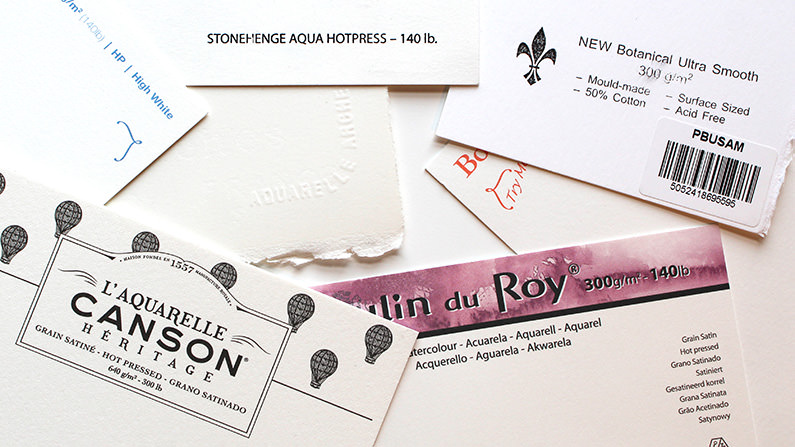
(Note, there are no paid links or promotions in this post!)
When you have been drawing since you were young, you sometimes find yourself still using the same brands of art materials that you first bought as a student, without really questioning your choice. This was the case for me when I started drawing professional portraits. For many years I continued to draw on a paper that I’d used since art school: Daler-Rowney’s ‘Smooth-Heavyweight’ cartridge pads which also come in a medium and coarse grain.
‘Cartridge’ is a term used mainly in the UK and Australasia to describe a good quality, heavyweight drawing paper. The quality of cartridge papers is actually rather variable, but the mid-priced Daler-Rowney paper is very good: it weighs 220 gsm making it hard to accidentally crease or dent, and is sized internally giving it extra durability. I still think it can take more rubbing out than any other paper I’ve used.
The surface is very smooth and well suited to drawing detailed portraits. I didn’t particularly like the off-white colour which has a pinkish tinge that I wished was more creamy, but in every other way it performed very well for me. I never felt it necessary to upgrade to thicker more expensive cartridge which I would have had to buy by the sheet and cut down.
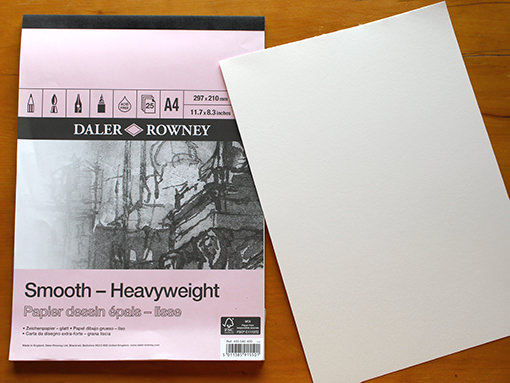
Like most cartridge papers the Daler-Rowney pads declare themselves to be ‘acid-free’. I didn’t entirely know what this meant, but just assumed it was a guarantee my paper would never suffer acid damage. Later I learned about how wood pulp used to make paper should always be treated to remove the ‘lignin’ content from the cellulose. These lignins are what cause paper to go yellow as they degrade over time and give off acid.
If a pad of paper is labelled ‘acid-free’ then it may mean that the wood pulp used to make the paper has been treated in this way. However it’s impossible to be sure, because some cheaper papers are simply given an alkalising bath of calcium carbonate in order to raise their pH level to neutral and allow their manufacturers to claim that they are ‘acid-free’ or acid-neutral’. This type of paper which still contains lignins will eventually go yellow.
What is more even if a wood pulp paper has been chemically bleached, it’s still not possible to remove the lignin content so completely that yellowing will never occur. Eventually all wood pulp paper will start to yellow, but with properly treated paper this may take many years. It depends on how the paper is kept and how much light it is exposed to: kept in a drawer or a portfolio it will keep its colour longer than paper hung on a wall.
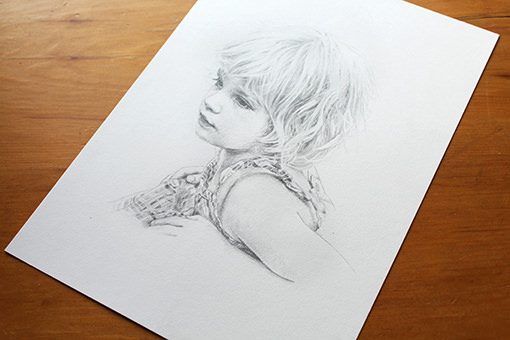
Once I’d learned all about the acids in wood pulp and their treatments, I began to feel doubtful about my choice of drawing paper. The Daler paper says it’s acid free but it doesn’t specifically state that the lignins have been removed. And even if I knew this for sure, how could I tell how thoroughly the pulp had been bleached and whether an extra alkali reserve had been added for further protection? This is common practice for good quality watercolour paper. Most professional grade watercolour paper is made from cotton fibres instead of wood pulp. In fact cotton paper like this is the only kind that is truly ‘acid free’, because cotton contain no lignins to begin with.
I dug out some old college drawings from a couple of decades ago from the attic and found that most of them did indeed now look a bit yellow. Then I took a drawing that I made about eight years ago out of its frame and compared it to a fresh sheet from my Daler-Rowney pad. There was some distinct and unpleasant yellowing around the edges which I think was simply ‘acid migration’, meaning that acid from the untreated backing board had leached into it.
The overall shade of the paper didn’t look noticeably different, but I was still concerned because I sell portraits to customers who plan to hand them down through the family for generations. I didn’t want to give them a drawing made on paper that didn’t meet archival standards and might be turning an unattractive yellow colour in 15 years time, especially if they hung it in direct sunlight. Acidic paper also encourages foxing damage, if their drawing was hung on a cold wall.
The problem with cartridge or any kind of drawing paper in the UK is that unlike with watercolour paper ranges, their manufacturers give no details about their archival qualities. Only the more expensive ‘Snowdon’ cartridge paper – sold by most UK art shops in sheet form – is specified in its marketing information as being made from treated pulp. In fact it says that is ‘Woodfree’ which is a confusing term that is a shortening of ‘groundwood free’. Groundwood is wood pulp that has been ground mechanically, but not broken down chemically.
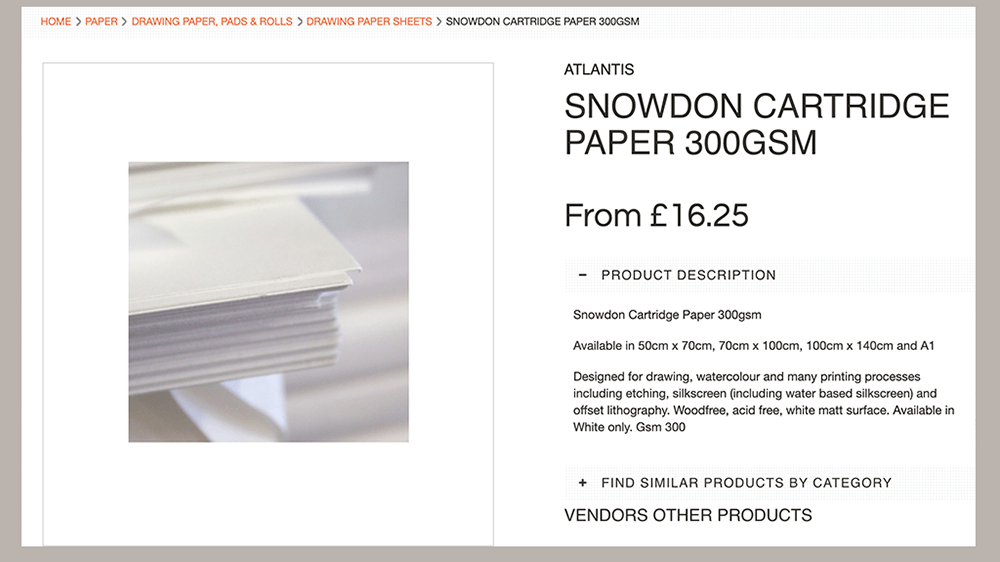
Unlike the Snowdon paper, most drawing paper simply doesn’t specify whether it is made from treated pulp, or untreated groundwood dunked in an alkalising bath. Winsor & Newton’s cartridge paper range gives no clue, other than the usual generic ‘acid-free’ statement.
I started to wonder whether a good quality watercolour paper made from naturally acid-free cotton and given an extra alkali reserve, would be a safer bet. Could I draw on a watercolour paper? I’d never really considered this before, but whilst researching into different papers I suddenly realised that artists were drawing on papers originally produced for different types of work: for watercolour painting, for printmaking or for mixed media. Just because a paper is marketed for use in one type of medium doesn’t mean you can’t use it for another, so long as isn’t actually unsuitable in some way.

Having recently started working in watercolours again for the first time in years, I already had a collection of many little watercolour paper samples and I ordered even more. I chose a ‘hot press’ finish which is the smoothest type of watercolour paper because I didn’t want something very textured for drawing finely detailed portraits.
Premium watercolour paper is made on a cylindrical mould machine, and I found that with mould-make paper, one side of the paper is always smoother than the other side. This is known as the ‘wire’ side of the paper and is the side where the pulp is not in contact with the layer of felt it is placed on to after being collected from a vat of water by a rotating mesh-covered cylinder. This side has less texture than the front of the paper, although occasionally the tiny wire mesh can leave a visible imprint.
Some of the paper samples I received were too textured, even on the wire side. Winsor & Newton’s watercolour paper had a really rough grain even in the hot press finish. Canson’s Heritage and Moulin du Roy papers are both lovely for painting but felt sort of fibrous and strange to draw onto.
I would have considered the wood-pulp paper Bockingford paper because it’s also made by St Cuthburts Mill and is probably as archival as a wood paper gets, with an alkali buffer to raise its pH to over 7. However it felt too smooth, as did my favourite watercolour paper Fabriano’s Fabriano Artistico, and Legion’s Stonehenge Aqua which was the smoothest of all with almost no tooth.
Fabriano 5 paper had a pretty good texture, but I didn’t want to use a paper containing OBAs (optical brightening agents). For this reason I also eliminated St. Cuthberts Mill’s new Botanical paper, although their nice Saunders Waterford paper was a contender, as was Langton’s Prestige paper. The very closest in texture to my old cartridge paper turned out to be the famous Aquarelle paper made by Arches.
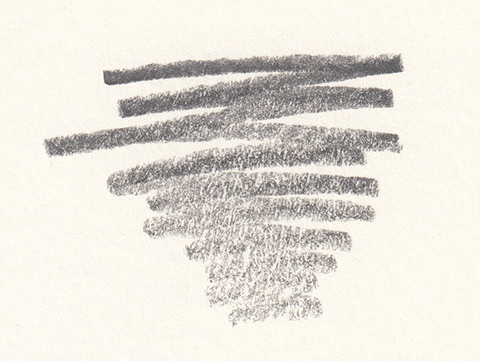
Daler-Rowney Smooth-Heavyweight cartridge
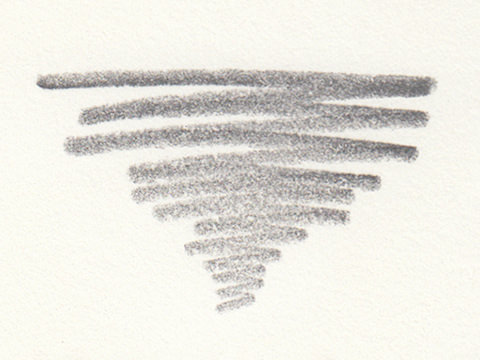
Arches Aquarelle paper
However when I actually tried drawing onto the Arches paper and the other watercolour papers, I felt that something wasn’t right. For starters none of them seemed to take take erasing as well as my old cartridge, which is really important because I draw a lot with my erasers: layering shading and cutting back into the pencil to create highlights. The Arches could take erasing with the battery eraser very well but if I overworked it by using my putty eraser a few times the paper surface appeared disturbed and the fibres started looking visible and sort of ‘hairy’.
The colour of the pencil looked different when applied to watercolour paper than it did on cartridge: much more grey and weaker in tone. I assumed this was due to the heavy sizing that’s applied to watercolour papers. Additionally, although the pencil felt like it was gliding over the paper in a very pleasant way the papers all seemed a bit too soft to offer enough resistance against it and the result was that my marks all had a streaky darker ridge in each stroke, as if the graphite was being applied unevenly.
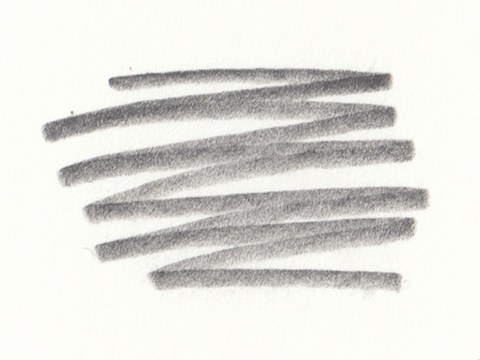
Uneven tones on Bockingford paper
I explored other options, ordering Strathmore’s 500 series Bristol board from the US which is their top quality, cotton fibre bristol board. I’d not even heard of bristol board before (it’s a multi-ply stiff sheet often favoured by illustrators) and found the ‘plate’ surface too smooth. I managed to get some of Strathmore’s wood-pulp fibre 400 Series Drawing Paper in the ‘vellum’ finish but wasn’t impressed with the feel of it, and besides it was too grainy.
Next I tried a few Arches papers designed for printmaking, but also sometimes used to draw on. I ordered a sample of their Velin paper, their Velin 80 (an unsized paper often used for screen printing) and a sheet of BFK Rives paper. The Velin was too textured and soft and the Velin 80 was super smooth but being unsized it couldn’t take rubbing out at all. The BFK Rives was lovely and a very close contender for the top spot, but was just a tiny bit too textured and soft.
A winner at last
Finally I ordered a sample book of the US company Legion’s Stonehenge fine art paper. This is one of the few cotton fibre papers marketed specifically for drawing which you can find in the UK (originally it was actually developed for printmaking but it’s now a popular drawing paper). Only Jacksons import it and I felt a bit uncomfortable to have just one supplier, but at least the price was quite reasonable and actually less than some European papers. Although made from cotton, the pencil behaved on this paper like it did on my cartridge pad: the graphite went on evenly with no ridging and no greying effect.
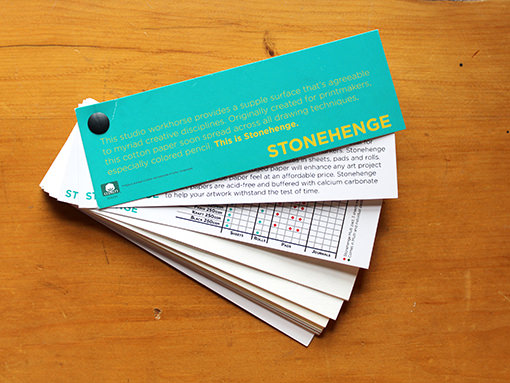
The 320gsm paper in the sample book had exactly the right texture, but you can’t get it in the UK. The 250 gsm (90lb) sample was very slightly more textured that I’d have liked even on the wire side but not so much that I thought I couldn’t adjust to it. The ‘polar white’ colour in 250 gsm was smoother (and wasn’t really super white but an acceptable off-white colour) but is only available in sheet form and since Jacksons don’t tend to package their sheet paper well I wasn’t confident it would arrive without creases. So I settled for the 250 gsm paper in regular white, which comes in pads of convenient sizes.
The Stonehenge paper seemed to have a more robust surface than the watercolour papers and didn’t go ‘hairy’ if I erased the same place several times. It didn’t do quite as well as the Daler-Rowney cartridge when I used the battery powered eraser on it, but it was okay. I really liked the gentle creamy off-white colour, and when I applied my pencils I got the same degree of blackness from the graphite that I was used to.
It’s hard to establish exactly what kind of chemical treatments the paper has received. Being 100% cotton it’s lignin-free and apparently it is ‘buffered with calcium carbonate’ . I was a bit confused because the description by Legion calls it ‘pH neutral’ which seems to suggest that it’s not any extra alkaline. However since it’s a naturally acid free cotton paper I’m not too concerned. I always advise my customers to hang a drawing somewhere it doesn’t receive direct sunlight and to use acid free mounts and backing boards to avoid acid migration.
© Article rights reserved portrait sketch artist UK Anna Bregman
CATEGORIES
DRAWING PEOPLE
DRAWING ANIMALS
DRAWING MATERIALS
OIL PAINTING
WATERCOLOUR
PAINTING MATERIALS
FRAMING

